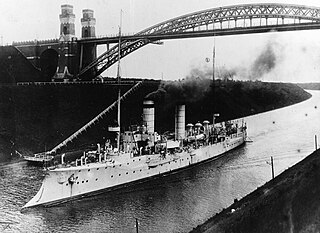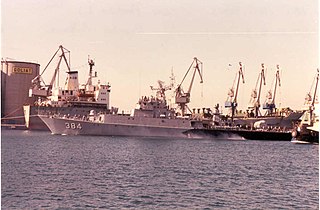
Nuclear marine propulsion is propulsion of a ship or submarine with heat provided by a nuclear reactor. The power plant heats water to produce steam for a turbine used to turn the ship's propeller through a gearbox or through an electric generator and motor. Nuclear propulsion is used primarily within naval warships such as nuclear submarines and supercarriers. A small number of experimental civil nuclear ships have been built.

A deep-submergence vehicle (DSV) is a deep-diving crewed submersible that is self-propelled. Several navies operate vehicles that can be accurately described as DSVs. DSVs are commonly divided into two types: research DSVs, which are used for exploration and surveying, and DSRVs, which are intended to be used for rescuing the crew of a sunken navy submarine, clandestine (espionage) missions, or both. DSRVs are equipped with docking chambers to allow personnel ingress and egress via a manhole.

The Type 206 is a class of diesel-electric submarines (U-boats) developed by Howaldtswerke-Deutsche Werft (HDW). Its design is based on the preceding Type 205 submarine class. These small and agile submarines were built during the Cold War to operate in the shallow Baltic Sea and attack Warsaw Pact shipping in the event of military confrontation. The pressure hulls were built out of non-magnetic steel to counter the threat of magnetic naval mines and make detection with MAD sensors more difficult. The low emission profile allowed the submarines in exercises to intrude even into well-protected opposing forces such as carrier formations with their screen.

SMS Arcona was the ninth member of the ten-ship Gazelle class of light cruisers that were built for the German Kaiserliche Marine in the late 1890s and early 1900s. The Gazelle class was the culmination of earlier unprotected cruiser and aviso designs, combining the best aspects of both types in what became the progenitor of all future light cruisers of the Imperial fleet. Built to be able to serve with the main German fleet and as a colonial cruiser, she was armed with a battery of ten 10.5 cm (4.1 in) guns and a top speed of 21.5 knots. Arcona was a modified version of the basic Gazelle design, with improved armor and additional coal storage for a longer cruising range.

The first icebreaker Krassin, or Krasin, was built for the Imperial Russian Navy as Svyatogor. She had a long, distinguished career in rescue operations, as well as a pathfinder and explorer of the Northern Sea Route. She has been fully restored to operating condition and is now a museum ship in Saint Petersburg.

Ivan Susanin class, also known by its Soviet designation Project 97P, is a series of icebreaking patrol ships built for the Soviet Navy and KGB Border Troops, and today operated by the Russian Navy and FSB Border Service.
Bollinger Shipyards is an American constructor of ships, workboats and patrol vessels. Its thirteen shipyards and forty drydocks are located in Louisiana and Texas. Its drydocks range in capacity from vessels of 100 tons displacement to 22,000 tons displacement. The firm was founded in 1946.
Icebreaker Eisvogel is an icebreaker employed by the Port of Vienna, Austria. Eisvogel clears ice in all three of Vienna's harbors. She is employed when the ice becomes a few centimetres in thickness. In 1985 she cleared ice that was 60 centimetres (24 in) thick.
Hitzler Werft is a shipyard in Lauenberg, Germany, just outside Hamburg. The company was founded in 1885 by Johann Georg Hitzler as a boat repair yard, and went on to build barges, trawlers, freighters, tankers, tugs, launches, barges and icebreakers.

Frankfurt is a prototype river icebreaker constructed by Hitzler Werft for icebreaking duties on the Elbe River, Oder River, and canals in Germany, operated by the Wasser und Schifffahrtsamt Eberswalde. She was built in 2002. Three further vessels, built to a similar design, were ordered by the Wasser und Schifffahrtsamt in 2009.

Ilya Muromets, Russian designation Project 21180, is a Russian icebreaker built by Admiralty Shipyard in Saint Petersburg and commissioned on 30 November 2017. She is the first icebreaker built for the Russian Navy in almost 40 years.
A number of icebreakers have been named Eisbär, German for "polar bear":

Dobrynya Nikitich class, also known by its Soviet designation Project 97, is a diverse series of diesel–electric icebreakers and other icebreaking vessels built in the Soviet Union. In total, 32 vessels were built in various configurations for both civilian and naval service in the 1960s, 1970s and early 1980s, and several remain in service in Russia as of 2024.

Eisvogel was an icebreaker in the Kriegsmarine during World War II. After the war, the ship served in the Soviet Union until 1972.

KRI Pati Unus (384) is a Kapitan Patimura-class corvette that used to be operated by the Indonesian Navy. Before her service in Indonesia, ship was part of the East German Volksmarine, as Ludwigslust (232).

KRI Memet Sastrawiria (380) is a Kapitan Patimura-class corvette currently operated by the Indonesian Navy. Before her service in Indonesia, the ship was part of the East German Volksmarine, as Bützow(244).

Dobrynya Nikitich was a Soviet and later Russian Navy icebreaker in service from 1960 until 1998. It had two sister ships, Purga (1961–2012) and Vyuga (1962–1991).

Ilya Muromets was a Soviet Navy icebreaker in service from 1965 until 1993. It had a 1966-built sister ship Buran.

Peresvet was a Soviet and later Russian Navy patrol icebreaker in service from 1970 until 2011. It had a 1968-built sister ship Sadko.















